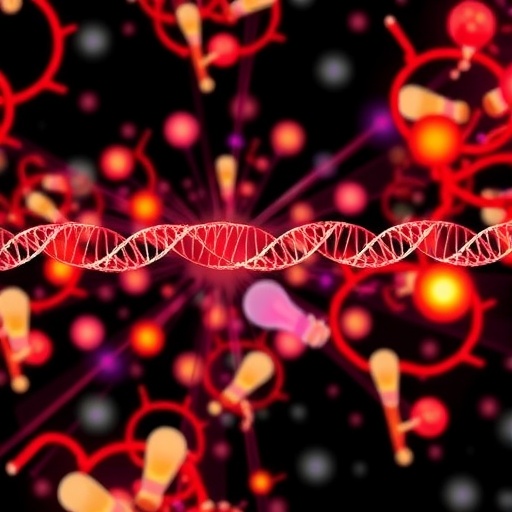In a groundbreaking leap for human genomics, researchers have unveiled the intricate mechanisms governing the formation and spread of Robertsonian chromosomes, a principal driver of chromosomal reorganization linked to both evolutionary processes and various genetic disorders. This study employs cutting-edge sequencing technologies and sophisticated assembly algorithms to chart the enigmatic landscape of these fused chromosomes, offering unprecedented insights into their molecular origin and stability.
The investigation began with the cultivation and preparation of human lymphoblastoid cell lines, whose genomic DNA was meticulously extracted to preserve ultra-long strands spanning from 50 kilobases up to a staggering one megabase. Utilizing Oxford Nanopore Technology (ONT) PromethION sequencing and PacBio’s HiFi sequencing platforms, the team generated high-fidelity, phased genome assemblies. These assemblies integrated ultra-long ONT reads and high-accuracy PacBio reads, bolstered by Hi-C data capturing chromosomal contacts, enabling the resolution of complex genomic regions typically elusive to sequencing efforts.
Central to their assembly strategy was the deployment of the Verkko assembler, a state-of-the-art tool designed to leverage long and accurate reads with Hi-C phasing information to untangle the graph of overlapping sequences. The researchers deftly identified and collapsed redundant ribosomal DNA (rDNA) nodes, introducing telomere annotations that marked chromosome termini. In their refined graph models, the Robertsonian translocations emerged vividly, allowing for extraction of complete assembly paths despite the challenges posed by gaps—a single gap in two of the three studied cell lines and two gaps in the third, which required manual curation.
To ascertain the integrity of their assemblies, the study employed Merqury for reference-free assessment, which leverages k-mer analysis to calculate assembly completeness and error rate in a phred-scaled fashion. Concurrently, gene content was evaluated by compleasm, an advanced BUSCO-based tool tailored with a primate-specific gene set comprising nearly 14,000 genes. Both approaches confirmed the high accuracy and completeness of these de novo human genome reconstructions, essential for credible biological inferences.
Diving deeper into the genomic intricacies surrounding Robertsonian chromosomes, the team investigated patterns of PRDM9 binding site distribution, acknowledging PRDM9’s pivotal role in meiotic recombination hotspot specification. By scanning 147 human haploid genomes for canonical 13-mer motifs associated with PRDM9 binding, they quantified motif densities within SST1 satellite arrays—a subtype of repetitive DNA intrinsic to acrocentric chromosome centromeres. Their analysis extended to related non-human primate genomes, such as chimpanzee, providing evolutionary context and highlighting conserved versus divergent binding patterns.
The interrogation of SST1 repeats revealed a significant spatial association with segmental duplications, DNA segments duplicated in the genome that contribute to structural variation and evolution. Utilizing permutation testing on a vast dataset of 147 haplotype-resolved human genomes, the team demonstrated a non-random co-localization of SST1 arrays and segmental duplications, underscoring their collective influence on genome architecture and the genesis of Robertsonian fusions.
Complementing the genome-scale analyses, meticulous manual characterization of SST1 monomers was performed through dot plot visualization, consensus sequence refinement, and phylogenetic reconstruction using maximum-likelihood models honed by appropriate substitution parameters. This thorough inspection illuminated the sequence variation and evolutionary relationships among satellite repeats within and across species.
Chromosome spreads, fluorescence in situ hybridization (FISH), and immunoFISH techniques anchored the study in a cytogenetic framework, bridging sequencing data with visual evidence. By deploying biotinylated BAC probes targeting SST1 regions alongside centromeric probes, and coupling these with antibodies recognizing centromere proteins CENP-B and CENP-C, the researchers illuminated the spatial organization and protein composition of these specialized chromosomal domains. High-resolution confocal and super-resolution microscopy facilitated the acquisition of multi-dimensional image stacks, enabling fine-scale intensity profiling and quantitative analyses.
In parallel, comprehensive methylation profiling assessed the epigenetic landscape associated with Robertsonian chromosomes. Leveraging methylation-sensitive basecalling of both HiFi and ONT reads, the team employed custom pipelines to map 5-methylcytosine modifications across CpG sites, elucidating patterns that may underlie chromosomal behavior during cell division and genomic stability.
The integration of CUT&RUN and CUT&Tag assays extended the epigenomic profiling to chromatin interactions, specifically targeting CENP-A, a histone variant essential for kinetochore assembly and chromosome segregation. By preparing libraries from chromatin fragments isolated via antibody-mediated micrococcal nuclease cleavage or transposase-directed tagging, the team achieved precise localization of centromeric nucleosomes within their newly assembled genomes. Subsequent high-throughput sequencing and bioinformatics workflows refined the mapping of centromeric protein-DNA complexes, connecting chromatin states with Robertsonian chromosomal features.
Complementary Hi-C data analysis contextualized these findings within three-dimensional genome organization, delineating contact frequency maps that unveiled the higher-order folding and proximity relationships of chromosomes harboring Robertsonian fusions. Employing bias-corrected normalization and multi-resolution visualization techniques, the researchers charted the topological nuances distinguishing normal and rearranged chromosomes.
This integrative approach, blending ultra-long read sequencing, epigenetics, cytogenetics, and 3D genome mapping, casts new light on the formation and propagation of human Robertsonian chromosomes. Beyond resolving the structural complexities of these chromosomes, the study charts a path toward understanding their roles in human variation, fertility, and chromosomal disorders, marking a watershed moment in genomics research that marries technological innovation with biological discovery.
Subject of Research: Human Robertsonian chromosome formation and propagation.
Article Title: The formation and propagation of human Robertsonian chromosomes.
Article References:
de Lima, L.G., Guarracino, A., Koren, S. et al. The formation and propagation of human Robertsonian chromosomes. Nature (2025). https://doi.org/10.1038/s41586-025-09540-8
Image Credits: AI Generated
Tags: chromosomal contactschromosomal reorganizationgenetic disordersgenomic data integrationhuman genomicshuman lymphoblastoid cell linesOxford Nanopore TechnologyPacBio HiFi sequencingRobertsonian chromosomessequencing technologiesultra-long DNA strandsVerkko assembler





